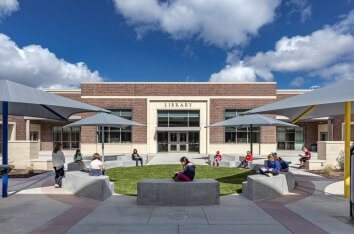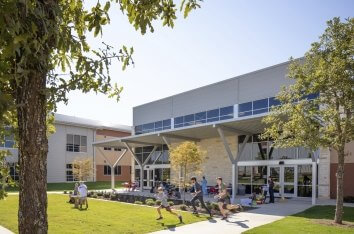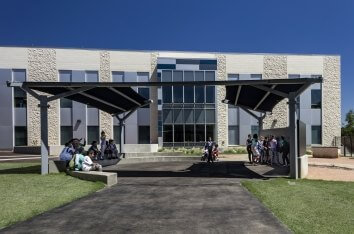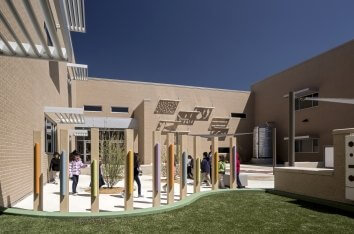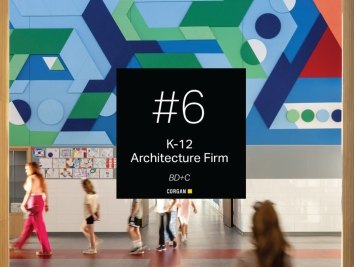Is the School Building Causing Stress for Students and Teachers?
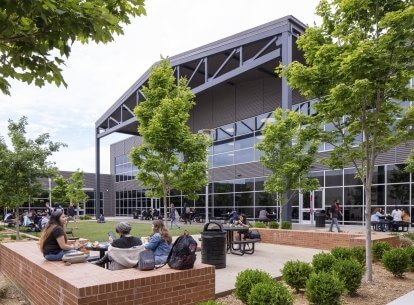
Students of all ages are under a great deal of stress stemming from various sources. There are shared developmental challenges students face and unique life circumstances that every student may be carrying with them into the classroom.

Research shows that mood disorders, anxiety, and suicidal thoughts have increased along with academic pressure, social media use, isolation, and bullying (Walker, 2018; Blad, 2021). When we consider the overlay of global events like COVID-19 and its exacerbation of existing challenges and inequities, it is clear that designing to mitigate sources of stress and to support mental and emotional health is of critical importance. Research-based insight, educational practices, and the design of learning environments can work together to meet the needs of the whole student, including their health, well-being, and academic performance.
Sources of Stress in the Learning Environment
The physical learning environment can be an effective tool for supporting students’ health, well-being, and academic performance. However, it can also present its own sources of stress and discomfort that need to be mitigated in the design of education facilities to support the health, well-being, and academic success of every student. These potentially problematic features may include:
Sensory Factors: Students are continuously surrounded by an abundance of sensory information to process from their environment. Attention is a limited cognitive resource and attempting to take in and sift through all of this sensory information can overwhelm a student’s capacity to strategically direct and focus their mental energy on relevant information (Matlin, 2006). Excessive noise in the learning environment can impact students’ ability to hear and concentrate, particularly for English language learners and children with hearing impairments and learning differences (Dockrell & Shield, 2006, Klatte et al, 2013).
One study found that as many as 1 in 6 children may have sensory processing issues that impact their ability to function and learn effectively in school- an environment full of sensory input outside of their control (Child Mind Institute, 2020; Ben-Sasson et al, 2009). Whether they are overly sensitive or under-sensitive to sensory stimulation, diagnosed with ADHD, OCD, Autism Spectrum Disorder, a developmental delay, or without another diagnosis; these challenges with the sensory environment can be distracting for both the impacted student and their classmates without proper accommodations (Child Mind Institute, 2020; Ben-Sasson et al, 2009).
Environmental Quality: Poor air quality can impact physical health and contribute to chronic respiratory diseases, the transmission of pathogens, and low concentration and attentiveness due to high CO2 levels (Texas A&M Forest Service; Ng, 2019). Thermal discomfort can be a source of distraction in the classroom and has been found to interfere with learning when thermal conditions are outside of a comfortable range (Uncapher, 2016). Lighting and access to natural light can have implications for students’ health, well-being, and learning outcomes, with daytime blue light and natural light providing measurable benefits for alertness and academic performance (Uncapher, 2016). Exposure to quality light during the day, particularly sunlight, has been found to translate to improved cognitive performance and learning outcomes and has important implications for a healthy circadian rhythm (Uncapher, 2016).
Developmental Misalignment: As students grow, their needs change, and their learning environment needs to evolve with them to align with their developmental stage. For example, as children reach adolescence, they desire greater autonomy, and there is a shift toward a peer-centered culture (Carolan et al, 2015). This is when students seek greater independence, relatedness, and self-efficacy; however, middle school students often experience a tightening of control, reduced quality of relationships with their teachers, and increased academic expectations (Carolan et al, 2015). As a result, students lack the emotional support they need during a particularly uncomfortable developmental transition, causing them stress and dissatisfaction (Carolan et al, 2015).
Limited Personalization: Every student comes to the classroom with their own unique set of strengths, passions, challenges, and experiences that shape the way they learn. Learning is not “one size fits all,” and designing schools for the “average” student can be ineffective (Dam & Siang, 2020). When students lack opportunities to guide their own learning in a space that meets their needs, their ability to learn and their enthusiasm for learning is compromised (Carvalho & Yeoman, 2018). Instead of feeling empowered, students can be left feeling frustrated. Physical discomfort in the learning space can be a source of stress and distraction. When students have limited choice in where they sit and limited opportunities to move around, they cannot create a learning space that supports their needs, ability to focus, or capacity to perform at their best (Ng, 2019; Posey, 2021). This can be especially problematic for students with sensory processing differences if they are not able to meet their own needs through personalized furniture, seat location, sensory breaks, fidgets, and other accommodations (Child Mind Institute, 2020)
Perception of Safety and Cleanliness: Threats to health and safety in our nations’ schools due to gun violence. Now, the threat of COVID-19 has introduced very real but intangible threats into the learning environment. Addressing the fear and insecurity that students and teachers may be feeling is a challenge because perceptions of safety and cleanliness are subjective — what brings one person comfort may be insufficient or fear-inducing for another. The anxiety and feelings of vulnerability that may result from security and cleanliness concerns can be distracting and stress-inducing (McLaughlin & Hatzenbuehler, 2009).
Emotionally Restrictive: In shared learning environments where students are regularly surrounded by peers and teachers, there is limited space for emotional expression without fear of judgment. If a student wants privacy or space to collect themselves while experiencing anxiety or emotional distress, a bathroom stall may be the only available option. With limited opportunities for psychological restoration, emotional expression, or emotional decompression, a student experiencing stress/distress may feel forced to internalize or externalize their feelings in an unhealthy way — leading to depression, anxiety, or behavioral problems (McLaughlin & Hatzenbuehler, 2009).
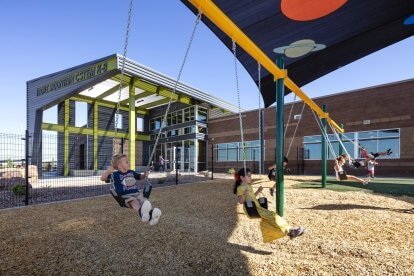
How Can Research Inform Wellness-Focused Design Strategies?
Through the rigorous study of the mind, brain, and human behavior, scientific research has contributed to a deeper understanding of the complexities of learning, development, well-being, and the many ways our environment impacts us - an incredible resource for educators and designers alike. Research quantifying the impact of our built and natural environment on health, well-being, and cognitive performance in authentic settings, such as classrooms and nature, highlights key opportunities for designing learning environments to reflect a holistic perspective on education.
The HEAD Project (Holistic Evidence and Design) was conducted in the UK by a team of researchers to assess the impact that the holistic learning environment has on primary school students' academic progress in their authentic classroom settings (Barrett et al, 2015). The researchers collected data from 153 classrooms on the built classroom environment's quality and pupil-level factors (Barrett et al, 2015). Through their analysis, the researchers were able to isolate the impact of the physical classroom environment, and they found that 16% of the variance in the academic progress of the students included in the study over one school year could be attributed to the quality of their built classroom environment (Barrett et al, 2015).
Nearly half (49%) of the environment-related impact on student performance was tied to “naturalness” factors, such as air quality, temperature, and most significantly, light, pointing to the importance of access to natural light and overall environmental quality for learning outcomes (Barrett et al, 2015). “Individualization” accounted for 28% of the total environmental factor variance, highlighting the importance of ownership, flexibility, and connection in the learning environment (Barrett et al, 2015). The remaining impact was due to “stimulation,” which indicates that classroom design needs to balance visual complexity and color to create a warm and engaging learning space without causing distraction or overstimulation (Barrett et al, 2015).
Physical Health: Researchers have identified a broad range of benefits we gain from exposure to wilderness and treescapes that promote overall health, including lower blood pressure and heart rate through nature’s relaxing influence, a healthier lifestyle and higher levels of physical activity, decreased risk of respiratory illness due to the clean air trees provide, improved thermal comfort, enhanced immune function, and more (Texas A&M Forest Service).
Stress Reduction Theory: Stress Reduction Theory states that natural environments have stress-reducing and psychologically restorative influence, while urban environments hamper recuperation (Ulrich et al, 1991). Research in Stress Reduction Theory (SRT) has found exposure to nature results in a “shift towards a more positively-toned emotional state” and has a physiologically restorative influence to reduce stress and improve physiological recovery and healing in hospital settings (Ulrich, 1999). Stress is known to negatively impact health and cognitive performance, making the application of this theory in learning spaces all the more worthwhile.
Nature and Wellbeing: A recent study found that the feeling of calm contentment that we get when we interact with nature, specifically in areas with an abundance of trees, means that our psychological needs are being met (Neuroscience News; Landon et al, 2020). Engaging with nature instills a sense of well-being due to the important physical and psychological health benefits. This feeling of well-being is linked to stronger feelings of place attachment (Neuroscience News; Landon et al, 2020).
Attention Restoration Theory: Attention Restoration Theory posits that exposure to natural environments is beneficial for overall mental health and has a cognitively beneficial influence (Kaplan, 1995). Attention is a limited cognitive resource, and spending a long day in the classroom, for example, can cause attentional fatigue, the symptoms of which are similar to ADHD, including an inability to focus and increased impulsivity and distractibility (Kaplan, 1995). Studies cite nature’s positive influence on factors like cognitive performance for both adults and children and a reduction in ADHD symptoms for children (Kaplan, 1995; Berman et al, 2008; Kuo et al, 2004; Stevenson et al, 2019).
Nature, Play, and Learning: When children engage in nature play, they show improved mood and are more likely to participate in constructive play, dramatic and imaginative play, exploratory play, and cooperative play (Dankiw et al, 2020; Merrill, 2020). Interestingly, the benefits of nature play also crossed over into the classroom and improved children’s originality, imagination, focus, attention, concentration, and timeliness, and decreased behavioral issues- providing further evidence for ART and SRT and compelling support for nature’s capacity to support a holistic perspective on education (Dankiw et al, 2020; Merrill, 2020).
Biophilia: Biophilia reflects our innate biological connection with nature (Terrapin Bright Green). By integrating nature and patterns from nature into the design of our built environment, we can infuse the health, well-being, and performance benefits that nature provides into the spaces we inhabit. Through the integration of natural systems, strengthening visual and non-visual connections with nature, incorporating natural elements, utilizing biomorphic forms and patterns, selecting natural materials, and integrating natural patterns of behavior, architecture can bring measurable benefits to our lives and take on an active role in promoting health and wellbeing in school facilities (Terrapin Bright Green).
Research-based insight has incredible potential to inform the design of wellness-focused learning environments. By understanding the impact of the physical environment on health, well-being, and student performance, learning environments can be designed to offer more than just a space to learn- they can provide opportunities for restoration and support overall wellness. Integrating nature and providing an optimized learning environment can help to address the many sources of stress that students carry on their shoulders and support the well-being and success of the whole student through the quality of their sensory environment, the richness of their social and emotional environment, and the opportunities they have for self-development, paving the way towards designing with empathy.
This is part two of a three-part series, where we dive into how the physical school building is causing stress for students and faculty, research-informed wellness-focused design strategies, and how to design educational buildings with empathy. Explore part 1 and part 3.
How to Avoid Unintentional or Subconscious Design Bias w/ Kate Canales
Listen in as Kate Canales, a Distinguished Senior Lecturer and Chair of the Department of Design at the University of Texas. With a background in mechanical engineering, product design, and design research, Kate focuses on building creative capacity inside organizations. Kate is also the founder and former director of SMU’s pioneering Master of Arts degree in Design and Innovation, which trains students of all backgrounds in human-centered design as a method for innovating in any field. Listen in as she shares her perspective on the biases, differences between human-centric design and design thinking, creating through the lens of experiential design, generating a positive impact through design, and teaching the next generation of creative designers.
References and Sources
Barrett, P., Davies, F., Zhang, Y., & Barrett, L. (2015). The impact of classroom design on pupils' learning: Final results of a holistic, multi-level analysis. Building and Environment, 89, 118-133.
Berman, M. G., Jonides, J., & Kaplan, S. (2008). The cognitive benefits of interacting with nature. Psychological science, 19(12), 1207-1212.
Blad, E. (2021, January 15). Schools grapple with student depression as data show problem worsening. Retrieved February 11, 2021, from https://www.edweek.org/leadership/schools-grapple-with-student-depression-as-data-show-problem-worsening/2019/03
Carolan, B. V., Weiss, C. C., & Matthews, J. S. (2015). Which middle school model works best? Evidence from the early childhood longitudinal study. Youth & Society, 47(5), 591-614.
Carvalho, L., & Yeoman, P. (2018). Framing learning entanglement in innovative learning spaces: Connecting theory, design and practice. British Educational Research Journal, 44(6), 1120-1137.
Dam, R., & Siang, T. (2020). Design thinking: Getting started with empathy. Retrieved February 11, 2021, from https://www.interaction-design.org/literature/article/design-thinking-getting-started-with-empathy
Dankiw KA, Tsiros MD, Baldock KL, Kumar S (2020) The impacts of unstructured nature play on health in early childhood development: A systematic review. PLoS ONE 15(2): e0229006. https://doi.org/10.1371/journal.pone.0229006
Dockrell, J. E., & Shield, B. M. (2006). Acoustical barriers in classrooms: The impact of noise on performance in the classroom. British Educational Research Journal, 32(3), 509-525. doi:10.1080/01411920600635494
Immordino‐Yang, M. H., & Damasio, A. (2007). We feel, therefore we learn: The relevance of affective and social neuroscience to education. Mind, brain, and education, 1(1), 3-10.
Kaplan, S. (1995). The restorative benefits of nature: Toward an integrative framework. Journal of Environmental Psychology, 15(3), 169-182. doi:10.1016/0272-4944(95)90001-2
Klatte, M., Bergström, K., & Lachmann, T. (2013). Does noise affect learning? A short review on noise effects on cognitive performance in children. Frontiers in Psychology, 4. doi:10.3389/fpsyg.2013.00578
Kuo, F. E., & Faber Taylor, A. (2004). A potential natural treatment for attention-deficit/hyperactivity disorder: evidence from a national study. American journal of public health, 94(9), 1580-1586.
Landon, A. C., Woosnam, K. M., Kyle, G. T., & Keith, S. J. (2020). Psychological Needs Satisfaction and Attachment to Natural Landscapes. Environment and Behavior, 0013916520916255.
Magolda, M. B. B. (2008). Three elements of self-authorship. Journal of College Student Development, 49(4), 269-284.
Matlin, M. W. (2006). Matlin: Cognition, 5th ed. Mississauga: J. Wiley Canada.
McLaughlin, K. A., & Hatzenbuehler, M. L. (2009). Stressful life events, anxiety sensitivity, and internalizing symptoms in adolescents. Journal of abnormal psychology, 118(3), 659.
Merrill, S. (2020, April 24). At Playtime, Open Fields and Trees Beat Seesaws and Monkey Bars. Retrieved February 02, 2021, from https://www.edutopia.org/article/playtime-open-fields-and-trees-beat-seesaws-and-monkey-bars
Neuroscience News. (2020, November 9). Human Wilderness Connection Has Psychological Roots and Could Reduce Disease Risk. Neuroscience News. https://neurosciencenews.com/wilderness-connection-psychology-17260/
Ng, B. (2019, July 23). Is there too much carbon dioxide in your classroom? Retrieved February 11, 2021, from https://letstalkscience.ca/educational-resources/stem-in-context/there-too-much-carbon-dioxide-in-your-classroom
Posey, A. (2021, January 13). Universal design for Learning (UDL): A teacher's guide. Retrieved February 11, 2021, from https://www.understood.org/en/school-learning/for-educators/universal-design-for-learning/understanding-universal-design-for-learning
Schutte, A. R., Torquati, J. C., & Beattie, H. L. (2017). Impact of urban nature on executive functioning in early and middle childhood. Environment and Behavior, 49(1), 3-30.
Shield, B., Connolly, D., Dockrell, J., Cox, T., Mydlarz, C., & Conetta, R. (2018). The impact of classroom noise on reading comprehension of secondary school pupils. In Proceedings of the Institute of Acoustics (Vol. 40, pp. 236-244). Institute of Acoustics.
Stanford SRN. (2008). What is Performance-Based Assessment? Retrieved December, 2020, from https://edpolicy.stanford.edu/sites/default/files/events/materials/2011-06-linked-learning-performance-based-assessment.pdf
Stevenson, M. P., Dewhurst, R., Schilhab, T., & Bentsen, P. (2019). Cognitive restoration in children following exposure to nature: evidence from the attention network task and mobile eye tracking. Frontiers in psychology, 10.
Terrapin Bright Green. 14 Patterns of Biophilic Design: Improving Health and Wellbeing in the environment.
Healthy Trees, Healthy Lives. https://healthytreeshealthylives.org
Ulrich, R. S. (1999). Effects of gardens on health outcomes: Theory and research. Healing gardens: therapeutic benefits and design recommendation.
Ulrich, R. S., Simons, R. F., Losito, B. D., Fiorito, E., Miles, M. A., & Zelson, M. (1991). Stress recovery during exposure to natural and urban environments. Journal of environmental psychology, 11(3), 201-230.
Uncapher, M. (2016, October 14). The science of effective learning spaces. Retrieved February 11, 2021, from https://www.edutopia.org/article/science-of-effective-learning-spaces-melina-uncapher
Walker, T. (2018, September 13). Are schools ready to tackle the mental health crisis? Retrieved February 11, 2021, from https://www.nea.org/advocating-for-change/new-from-nea/are-schools-ready-tackle-mental-health-crisis





